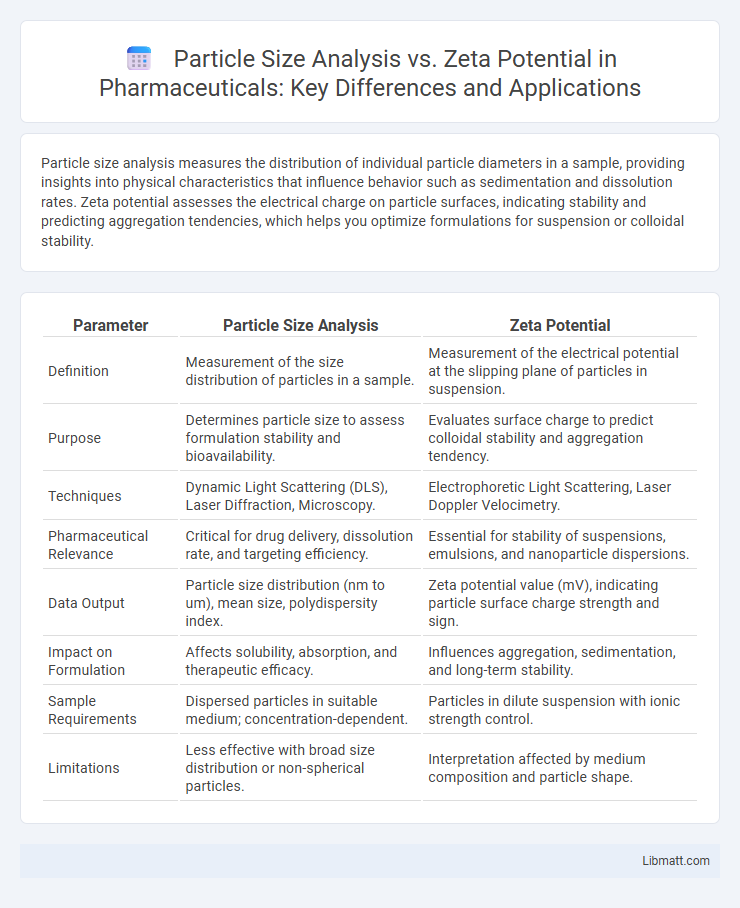Particle size analysis measures the distribution of individual particle diameters in a sample, providing insights into physical characteristics that influence behavior such as sedimentation and dissolution rates. Zeta potential assesses the electrical charge on particle surfaces, indicating stability and predicting aggregation tendencies, which helps you optimize formulations for suspension or colloidal stability.
Table of Comparison
| Parameter | Particle Size Analysis | Zeta Potential |
|---|---|---|
| Definition | Measurement of the size distribution of particles in a sample. | Measurement of the electrical potential at the slipping plane of particles in suspension. |
| Purpose | Determines particle size to assess formulation stability and bioavailability. | Evaluates surface charge to predict colloidal stability and aggregation tendency. |
| Techniques | Dynamic Light Scattering (DLS), Laser Diffraction, Microscopy. | Electrophoretic Light Scattering, Laser Doppler Velocimetry. |
| Pharmaceutical Relevance | Critical for drug delivery, dissolution rate, and targeting efficiency. | Essential for stability of suspensions, emulsions, and nanoparticle dispersions. |
| Data Output | Particle size distribution (nm to um), mean size, polydispersity index. | Zeta potential value (mV), indicating particle surface charge strength and sign. |
| Impact on Formulation | Affects solubility, absorption, and therapeutic efficacy. | Influences aggregation, sedimentation, and long-term stability. |
| Sample Requirements | Dispersed particles in suitable medium; concentration-dependent. | Particles in dilute suspension with ionic strength control. |
| Limitations | Less effective with broad size distribution or non-spherical particles. | Interpretation affected by medium composition and particle shape. |
Introduction to Particle Size Analysis
Particle size analysis measures the dimensions of particles within a material, providing critical data on distribution, shape, and aggregation affecting product performance and stability. Techniques such as laser diffraction, dynamic light scattering, and microscopy offer precise characterization essential for industries like pharmaceuticals, food, and materials science. Understanding particle size aids in optimizing formulation, processing, and quality control, directly impacting end-use functionality.
Understanding Zeta Potential
Understanding zeta potential is crucial for assessing the stability of colloidal dispersions, as it measures the electrical charge on particle surfaces that influences aggregation behavior. Particle size analysis alone provides information on the physical dimensions of particles, but zeta potential offers insights into the electrostatic repulsion or attraction affecting your sample's suspension stability. Combining both techniques allows for a comprehensive evaluation of particle behavior in various formulations and industrial applications.
Key Differences Between Particle Size and Zeta Potential
Particle size analysis measures the physical dimensions of particles, typically expressed in nanometers or micrometers, providing critical data on particle distribution and aggregation. Zeta potential quantifies the electrical charge on particle surfaces, influencing stability and predicting colloidal dispersion behavior. While particle size indicates morphological characteristics, zeta potential reveals electrokinetic properties, both essential for understanding suspension stability and behavior in formulations.
Importance of Particle Size Analysis in Material Science
Particle size analysis is crucial in material science for determining the distribution and dimensions of particles, which directly impact the physical and chemical properties of materials such as reactivity, strength, and stability. Zeta potential complements this by measuring the surface charge, influencing particle dispersion and aggregation behavior in suspensions. Understanding both parameters enhances Your ability to optimize formulations and predict material performance in applications like pharmaceuticals, ceramics, and coatings.
Role of Zeta Potential in Colloidal Stability
Zeta potential measures the electrical charge on particle surfaces, directly influencing colloidal stability by preventing particle aggregation through electrostatic repulsion. Particle size analysis provides data on the physical dimensions of particles but does not inform about surface charge or interaction forces. Understanding zeta potential is crucial for optimizing formulations in pharmaceuticals, food, and cosmetics where stable dispersions prevent settling and clumping.
Techniques Used for Particle Size Analysis
Techniques used for particle size analysis include dynamic light scattering (DLS), laser diffraction, and electron microscopy, each providing precise measurements of particle dimensions at the nanoscale or microscale. These methods reveal information about the size distribution, which is crucial for understanding material behavior, stability, and performance. Your choice between particle size analysis and zeta potential depends on whether you need to assess size distribution or surface charge to optimize formulation stability.
Methods for Measuring Zeta Potential
Zeta potential measurement techniques include electrophoretic light scattering (ELS), which assesses particle velocity under an electric field to determine surface charge. Electroacoustic methods analyze the electric signal generated by particle motion in a suspension, providing zeta potential without dilution. These methods complement particle size analysis by offering insights into colloidal stability and surface charge characteristics essential for formulation optimization.
Applications of Particle Size and Zeta Potential Data
Particle size analysis provides critical information for optimizing product formulations in pharmaceuticals, cosmetics, and food industries by determining the distribution and average size of particles, which influence texture and stability. Zeta potential data measures the surface charge of particles, essential for predicting colloidal stability, preventing aggregation, and guiding the design of nanoparticles in wastewater treatment and drug delivery systems. Understanding both particle size and zeta potential enables you to enhance suspension stability, improve product shelf life, and tailor materials for specific industrial and biomedical applications.
Interpreting Results: Particle Size vs Zeta Potential
Interpreting particle size analysis results provides insights into the physical dimensions and distribution of particles in your sample, critical for understanding aggregation and stability trends. Zeta potential measurements reveal the surface charge and electrostatic repulsion between particles, which directly influences colloidal stability and predicts potential flocculation or dispersion. Combining both analyses offers comprehensive information to optimize formulation and improve product performance.
Choosing the Right Analysis for Your Research
Particle size analysis and zeta potential measurements serve distinct but complementary roles in material characterization. Particle size analysis quantifies the distribution of particle diameters, crucial for understanding formulation stability, sedimentation, and bioavailability, while zeta potential assesses surface charge, indicating colloidal stability and predicting aggregation behavior. Choosing the right analysis for your research depends on whether you need detailed size distribution data or insights into particle interaction and stability within your specific medium.
Particle size analysis vs zeta potential Infographic

 libmatt.com
libmatt.com